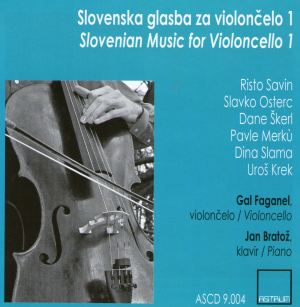 |
 |
|

|
Slovenian Music for Cello and Piano - Volume
1
Risto SAVIN (Friderik
ŠIRCA) (1859-1949)
Sonata for Violoncello and Piano, op.22 (1922) [17:25]
Slavko OSTERC (1895-1941)
Partita for Violoncello and Piano (1929) [14:00]
Dane ŠKERL (1931-2002)
Two meditations for Violoncello and Piano (1989) [5:09]
Three Intermezzos for Violoncello Solo (1987) [10:06]
Pavle MERKÙ (b.1927)
Madrigal for Violoncello Solo (1985) [3:58]
Dina SLAMA (b.1941)
Song for Violoncello (1994) [3:47]
Uroš KREK (1922-2008)
Sonata for Violoncello and Piano (1984) [22:22]
 Gal Faganel (cello), Jan Bratož (piano)
Gal Faganel (cello), Jan Bratož (piano)
rec. St. Anne Parish Church, Tunjce, Slovenia; Hall of St. Stanislav’s
Institution, Ljubljana, Slovenia, 1-4 July 2008.
 ASTRUM ASCD 9.004 [77:13]
ASTRUM ASCD 9.004 [77:13]
|
|
|
With this disc to review I can’t help opening with British
comedy icons Monty Python’s famous phrase “and now
for something completely different”. Slovenian music for
cello and piano and solo cello and what a discovery! To say
that I know nothing about music from Slovenia is not to overstate
the case. That’s one of the many joys of reviewing: the
learning curve is never ending.
The first surprise is that the composer of the first piece on
the disc is by someone who literally led a double life. Risto
Savin, composer, was born Friderik Širca and was a General
in the army! As a composer he is credited with creating a Slovenian
national tradition of opera. In his Sonata for Violoncello
and Piano, op.22, written in 1922, each instrument is given
an equal role. I imagine it is quite tricky to play as the cello
is predominantly in the lower register whilst the piano is well
above. The opening movement’s main theme is beautifully
rich and, though the work was written in the 1920s it has much
more in keeping with one written in the late 19th
century. The first impression is that you are listening to a
piece by Brahms or Mendelssohn. In common with Brahms there
is much reference to the folk heritage of the region and it
is impossible not to know that we are in ‘central Europe’.
The second short movement has a lovely opening theme too as
does the third. The whole work brims with ideas, all of them
thoroughly explored and exploited. It is a piece that is highly
enjoyable with lush melodies and I imagine one would never tire
of hearing it.
Though written a mere seven years after Savin’s work Slavko
Osterc’s Partita for Violoncello and Piano is a
world away in style with its roots firmly in the 20th
century. Osterc’s teachers included Emerik Beran, a pupil
of Leoš Janáček as well as Vítězslav
Novák and Alois Hába. The work begins with
spiky rhythms introduced on the piano before the cello joins
in to share them. The second movement begins much more calmly
with a melancholy theme on the cello which then becomes agitated.
The piano part mirrors the mood before calm is restored. A short
Interlude comes next in which the piano has the role
to itself, the cello taking no part at all. The final Fugue
has both instruments with an equal share of the material. It
completes a work that is a perfect example of the kind of modernist
experimentation that was prevalent in the interwar years.
Two short works by Dane Škerl follow, the first, Two
meditations for Violoncello and Piano was composed in 1989.
It can be considered an example of Slovenian avant-garde and
though stark in nature it is attractively melodious. His Three
Intermezzos for Violoncello Solo which dates from 1987 is
also spare but beautiful, exploiting the full range of the cello’s
register from its very lowest voice to its topmost notes across
three short movements. Pavle Merkù’s short Madrigal
for Violoncello Solo from 1985 is again avant-garde but
as he himself put it so eloquently “In contemporary music
I search - just like my predecessors did in the past - for directness,
experience and originality. What we termed ‘contemporary
music’ or ‘avant-garde’ (or call it by any
other name you like!) is in actual fact the expression of our
times. Just like all past periods, the present yields weeds,
degenerated crops and all kinds of speculation. However, it
also produces many great and true works of art. The development
of contemporary music can bestow on us absolutely nothing new
under the Sun”. Indeed, and I thought of that especially
when 2½ minutes in comes a little tune that reminded
me immediately of “Cherry Ripe”.
Dina Slama is the only Slovene woman composer represented here.
Her Song for Violoncello written in 1994 is another beautifully
simple piece that fully exploits the cello’s wonderfully
expressive eloquence. The final work on this fascinating disc
brings the piano back for Uroš Krek’s Sonata for
Violoncello and Piano, a substantial three movement work dating
from 1984. This is full of long flowing lines and a particularly
attractive tune in the second movement.
This disc is entitled Slovenian Music for Violoncello 1,
implying that there will be further releases of this repertoire
which will be worth hearing if this one is anything to go by.
It is a credit to a small country like Slovenia with a population
of little over two million that it has produced as many composers
as it has. The music is really interesting and memorable. There
are so many works as yet undiscovered and it is wonderful to
have the opportunity to hear them. This disc was a revelation
to me and will be to any music-lover. The two soloists play
the works with passion, commitment and skill and they have been
well recorded.
Steve Arloff
|
|

